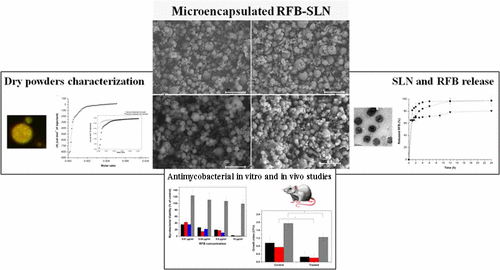当前位置:
X-MOL 学术
›
Mol. Pharmaceutics
›
论文详情
Our official English website, www.x-mol.net, welcomes your
feedback! (Note: you will need to create a separate account there.)
Microencapsulated Solid Lipid Nanoparticles as a Hybrid Platform for Pulmonary Antibiotic Delivery
Molecular Pharmaceutics ( IF 4.5 ) Pub Date : 2017-08-15 00:00:00 , DOI: 10.1021/acs.molpharmaceut.7b00169 Diana P. Gaspar 1 , Maria Manuela Gaspar 1 , Carla V. Eleutério 1 , Ana Grenha , Mateo Blanco , Lídia M. D. Gonçalves 1 , Pablo Taboada , António J. Almeida 1 , Carmen Remuñán-López
Molecular Pharmaceutics ( IF 4.5 ) Pub Date : 2017-08-15 00:00:00 , DOI: 10.1021/acs.molpharmaceut.7b00169 Diana P. Gaspar 1 , Maria Manuela Gaspar 1 , Carla V. Eleutério 1 , Ana Grenha , Mateo Blanco , Lídia M. D. Gonçalves 1 , Pablo Taboada , António J. Almeida 1 , Carmen Remuñán-López
Affiliation

|
Solid lipid nanoparticles (SLN) containing rifabutin (RFB), with pulmonary administration purposes, were developed through a technique that avoids the use of organic solvents or sonication. To facilitate their pulmonary delivery, the RFB-loaded SLN were included in microspheres of appropriate size using suitable excipients (mannitol and trehalose) through a spray-drying technique. Confocal analysis microscopy showed that microspheres are spherical and that SLN are efficiently microencapsulated and homogeneously distributed throughout the microsphere matrices. The aerodynamic diameters observed an optimal distribution for reaching the alveolar region. The dry powder’s performance during aerosolization and the in vitro drug deposition were tested using a twin-impinger approach, which confirmed that the microspheres can reach the deep lung. Isothermal titration calorimetry revealed that SLN have higher affinity for mannitol than for trehalose. Upon microsphere dissolution in aqueous media, SLN were readily recovered, maintaining their physicochemical properties. When these dry powders reach the deep lung, microspheres are expected to readily dissolve, delivering the SLN which, in turn, will release RFB. The in vivo biodistribution of microencapsulated RFB-SLN demonstrated that the antibiotic achieved the tested organs 15 and 30 min post pulmonary administration. Their antimycobacterial activity was also evaluated in a murine model of infection with a Mycobacterium tuberculosis strain H37Rv resulting in an enhancement of activity against M. tuberculosis infection compared to nontreated animals. These results suggest that RFB-SLN microencapsulation is a promising approach for the treatment of tuberculosis.
中文翻译:

微囊化固体脂质纳米颗粒作为肺抗生素递送的混合平台。
含有利福布汀(RFB)的固体脂质纳米颗粒(SLN)具有肺部给药的目的,是通过避免使用有机溶剂或进行超声处理的技术开发的。为了促进其肺部递送,通过喷雾干燥技术,使用合适的赋形剂(甘露醇和海藻糖),将适当大小的RFB负载的SLN包括在微球中。共聚焦显微镜检查表明,微球是球形的,SLN被有效地微囊化并均匀地分布在整个微球基质中。空气动力学直径观察到到达肺泡区域的最佳分布。干粉在雾化和体外的性能使用双撞击器方法测试了药物沉积,证实了微球可以到达深肺。等温滴定量热法显示,SLN对甘露醇的亲和力高于对海藻糖的亲和力。当微球溶解在水性介质中时,SLN易于回收,并保持其理化性质。当这些干粉到达肺部深处时,预计微球会很容易溶解,从而释放出SLN,进而释放出RFB。的体内微囊RFB-SLN的生物分布表明,抗生素取得的测试器官15和30分钟后肺部给药。在鼠结核分枝杆菌感染模型中也评估了它们的抗分枝杆菌活性。与未治疗的动物相比,H37Rv菌株可增强抗结核分枝杆菌感染的活性。这些结果表明,RFB-SLN微囊化是治疗结核病的一种有前途的方法。
更新日期:2017-08-15
中文翻译:

微囊化固体脂质纳米颗粒作为肺抗生素递送的混合平台。
含有利福布汀(RFB)的固体脂质纳米颗粒(SLN)具有肺部给药的目的,是通过避免使用有机溶剂或进行超声处理的技术开发的。为了促进其肺部递送,通过喷雾干燥技术,使用合适的赋形剂(甘露醇和海藻糖),将适当大小的RFB负载的SLN包括在微球中。共聚焦显微镜检查表明,微球是球形的,SLN被有效地微囊化并均匀地分布在整个微球基质中。空气动力学直径观察到到达肺泡区域的最佳分布。干粉在雾化和体外的性能使用双撞击器方法测试了药物沉积,证实了微球可以到达深肺。等温滴定量热法显示,SLN对甘露醇的亲和力高于对海藻糖的亲和力。当微球溶解在水性介质中时,SLN易于回收,并保持其理化性质。当这些干粉到达肺部深处时,预计微球会很容易溶解,从而释放出SLN,进而释放出RFB。的体内微囊RFB-SLN的生物分布表明,抗生素取得的测试器官15和30分钟后肺部给药。在鼠结核分枝杆菌感染模型中也评估了它们的抗分枝杆菌活性。与未治疗的动物相比,H37Rv菌株可增强抗结核分枝杆菌感染的活性。这些结果表明,RFB-SLN微囊化是治疗结核病的一种有前途的方法。











































 京公网安备 11010802027423号
京公网安备 11010802027423号